Is a wheelie bin a vehicle? Federal Court judge finds answer not so simple
EXCLUSIVE: IS A wheelie bin a vehicle? That is the conundrum that has cluttered the minds of some in the legal fraternity for the past two years.

Law & Order
Don't miss out on the headlines from Law & Order. Followed categories will be added to My News.
YOU could be forgiven for thinking this question is a load of rubbish, but is a wheelie bin a vehicle?
That is the conundrum that has cluttered the minds of some in the legal fraternity for the past two years.
And for bin maker Sulo — which has produced more than 100 million wheelie bins in Australia — the answer amounts to a pile of cash, as the level of tax it pays to import wheels for its “mobile garbage bins” turns on the outcome.
But in a 24-page decision published by the Federal Court this week judge Mark Moshinsky found the answer is not as simple as it may seem and he has sent the question back to the Administrative Appeals Tribunal for a rethink.

For the record, the wheels Sulo imports for its wheelie bins are plastic and fitted with a solid rubber tyre of 200mm diameter.
The great wheelie bin debate began in November 2014 when a customs officer decided to classify the wheels under subheading 4012.90 of Schedule 3 of the Customs Tariff Act _ solid or cushion tyres of rubber _ and therefore not eligible for a tariff concession.
Sulo disagreed but an internal Australian Customs and Border Protection Service review upheld the decision in January 2015 Sulo took its case to the AAT.
After forensic consideration of the bin and wheels’ construction, the definition of a vehicle and relevant case law, the tribunal determined the “correct identification of the item is that it is a plastic wheel”.
And, as a part made specifically to be fitted to a Sulo wheelie bin, which, unlike other rubbish bins, is designed to not just hold garbage but transport it to the roadside, the tribunal found it should be classified under subheading 8716.90 as parts for “other vehicles, not mechanically propelled” used for the primary purpose of transporting goods or people.

The “Explanatory Notes to the Harmonised Commodity Description and Coding System” says this section covers hand or foot propelled vehicles that includes wheelbarrows, food carts, handcarts and even “small insulated barrows for use by ice cream vendors”.
The tribunal ruling made Sulo’s wheels eligible for a tariff concession under that section of the Act for non-inflatable rubber and/or plastic wheels of no more than 400mm diameter.
However, the Comptroller-General of customs thought that decision was rubbish and appealed to the Federal Court, arguing the AAT had erred by misconstruing the expression “other vehicles, not mechanically propelled” and not considering all other possible classifications.
Judge Moshinsky decided to send the matter back to the tribunal for redetermination, finding it had neither specifically determined whether the wheelie bin’s primary purpose was the transport of goods, nor considered all other possible classifications.
“On the assumption that the wheelie bins were not vehicles as described in heading 8716, the wheels would not be classified to subheading 8716.90.00,” he said. “The Tribunal would then need to consider other possible classifications for the wheels.”
